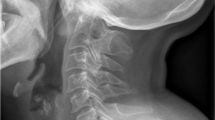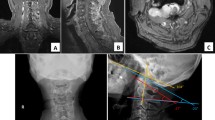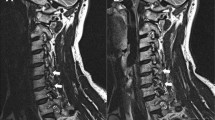Abstract
Purpose
We have revealed that the cause of postoperative dyspnea and/or dysphagia after occipito-cervical (O-C) fusion is mechanical stenosis of the oropharyngeal space and the O-C2 alignment, rather than total or subaxial alignment, is the key to the development of dyspnea and/or dysphagia. The purpose of this study was to confirm the impact of occipito-C2 angle (O-C2A) on the oropharyngeal space and to investigate the chronological impact of a fixed O-C2A on the oropharyngeal space and dyspnea and/or dysphagia after O-C fusion.
Materials and methods
We reviewed 13 patients who had undergone O-C2 fusion, while retaining subaxial segmental motion (OC2 group) and 20 who had subaxial fusion without O-C2 fusion (SA group). The O-C2A, C2–C6 angle and the narrowest oropharyngeal airway space were measured on lateral dynamic X-rays preoperatively, when dynamic X-rays were taken for the first time postoperatively, and at the final follow-up. We also recorded the current dyspnea and/or dysphagia status at the final follow-up of patients who presented with it immediately after the O-C2 fusion.
Results
There was no significant difference in the mean preoperative values of the O-C2A (13.0 ± 7.5 in group OC2 and 20.1 ± 10.5 in group SA, Unpaired t test, P = 0.051) and the narrowest oropharyngeal airway space (17.8 ± 6.0 in group OC2 and 14.9 ± 3.9 in group SA, Unpaired t test, P = 0.105). In the OC2 group, the narrowest oropharyngeal airway space changed according to the cervical position preoperatively, but became constant postoperatively. In contrast, in the SA group, the narrowest oropharyngeal airway space changed according to the cervical position at any time point. Three patients who presented with dyspnea and/or dysphagia immediately after O-C2 fusion had not resolved completely at the final follow-up. The narrowest oropharyngeal airway space and postoperative dyspnea and/or dysphagia did not change with time once the O-C2A had been established at O-C fusion.
Conclusions
The O-C2A established at O-C fusion dictates the patient’s destiny in terms of postoperative dyspnea and/or dysphagia. Surgeons should pay maximal attention when establishing the O-C2A during surgery, because their careless decision for the O-C2A may cause persistent dysphagia or a life-threatening consequence. We recommend that the O-C2A in O-C fusion should be kept at least at more than the preoperative O-C2A in the neutral position.





Similar content being viewed by others
References
Matsuyama Y, Kawakami N, Yoshihara H et al (2005) Long-term results of occipitothoracic fusion surgery in RA patients with destruction of the cervical spine. J Spinal Disord Tech 18(suppl 1):S101–S106
Tagawa T, Akeda K, Asanuma Y et al (2011) Upper airway obstruction associated with flexed cervical position after posterior occipitocervical fusion. J Anesth 25(1):120–122
Yoshida M, Neo M, Fujibayashi S, Nakamura T (2007) Upper-airway obstruction after short posterior occipitocervical fusion in a flexed position. Spine (Phila Pa 1976) 32(8):E267–E270
Ichinose K, Kozuma S, Fukuyama S et al (2002) A case of airway obstruction after posterior occipito-cervical fusion (in Japanese). Masui 51(5):513–515
Meakem TD, Meakem TJ, Rappaport W (1990) Airway compromise from prevertebral soft tissue swelling during placement of halo-traction for cervical spine injury. Anesthesiology 73(4):775–776
Dark A, Armstrong T (1999) Severe postoperative laryngeal oedema causing total airway obstruction immediately on extubation. Br J Anaesth 82(4):644–646
Lee YH, Hsieh PF, Huang HH, Chan KC (2008) Upper airway obstruction after cervical spine fusion surgery: role of cervical fixation angle. Acta Anaesthesiol Taiwan 46(3):134–137
Miyata M, Neo M, Fujibayashi S et al (2009) O-C2 angle as a predictor of dyspnea and/or dysphagia after occipitocervical fusion. Spine (Phila Pa 1976) 34(2):184–188
Ota M, Neo M, Aoyama T et al (2011) Impact of the O-C2 angle on the oropharyngeal space in normal patients. Spine (Phila Pa 1976) 36(11):E720–E726
Ataka H, Tanno T, Miyashita T, Isono S, Yamazaki M (2010) Occipitocervical fusion has potential to improve sleep apnea in patients with rheumatoid arthritis and upper cervical lesions. Spine (Phila Pa 1976) 35(19):E971–E975
Izeki M, Neo M, Ito H et al (2013) Reduction of atlantoaxial subluxation causes airway stenosis. Spine (Phila Pa 1976) 38(9):E513–E520
Shoda N, Takeshita K, Seichi A et al (2004) Measurement of occipitocervical angle. Spine (Phila Pa 1976) 29(10):E204–E208
Matsunaga S, Onishi T, Sakou T (2001) Significance of occipitoaxial angle in subaxial lesion after occipitocervical fusion. Spine (Phila Pa 1976) 26(2):161–165
Lee MJ, Bazaz R, Furey CG, Yoo J (2007) Risk factors for dysphagia after anterior cervical spine surgery: a two-year prospective cohort study. Spine J 7(2):141–147
Bazaz R, Lee MJ, Yoo JU (2002) Incidence of dysphagia after anterior cervical spine surgery: a prospective study. Spine (Phila Pa 1976) 27(22):2453–2458
Riley LH 3rd, Skolasky RL, Albert TJ, Vaccaro AR, Heller JG (2005) Dysphagia after anterior cervical decompression and fusion: prevalence and risk factors from a longitudinal cohort study. Spine (Phila Pa 1976) 30(22):2564–2569
Vaidya R, Weir R, Sethi A et al (2007) Interbody fusion with allograft and rh-BMP-2 leads to consistent fusion but early subsidence. J Bone Joint Surg Br 89(3):342–345
Haller JM, Iwanik M, Shen FH (2011) Clinically relevant anatomy of high anterior cervical approach. Spine (Phila Pa 1976) 36(25):2116–2121
Riley LH 3rd, Vaccaro AR, Dettori JR, Hashimoto R (2010) Postoperative dysphagia in anterior cervical spine surgery. Spine (Phila Pa 1976) 35(9 Suppl):S76–S85
Edwards CC 2nd, Karpitskaya Y, Cha C et al (2004) Accurate identification of adverse outcome after cervical spine surgery. J Bone Joint Surg Am 86(2):251–256
Martin S, Catarina I, Therese E, Claes O (2012) The dysphagia short questionnaire: an instrument for evaluation of dysphagia—a validation study with 12 months’ follow-up after anterior cervical spine surgery. Spine (Phila Pa 1976) 37(11):996–1002
Redlund-Johnell I (1988) Upper airway obstruction in patients with rheumatoid arthritis and temporomandibular joint destruction. Scand J Rhumatol 17(4):273–279
Keenan MA, Stiles CM, Kaufman RL (1983) Acquired laryngeal deviation associated with cervical spine disease in erosive polyarticular arthritis. Use of the fiberoptic bronchoscope in rheumatoid disease. Anesthesiology 58(5):441–449
Chen JJ, Branstetter BF 4th, Myers EN (2005) Cricoarytenoid rheumatoid arthritis: an important consideration in aggressive lesions of the larynx. AJNR Am J Neuroradiol 26(4):970–972
Ataka H, Isono S, Yamazaki M, Tanno T, Miyashita T (2011) Sleep-disordered breathing in patients with rheumatoid arthritis and upper cervical lesion (in Japanese). J Spine Res 2(1):35–42
Acknowledgments
The authors are grateful to all the staff of the Kyoto University for allowing them to study their patients and for their assistance.
Conflict of interest
No benefits in any form have been or will be received from a commercial party related directly or indirectly to the subject of this paper.
Author information
Authors and Affiliations
Corresponding author
Rights and permissions
About this article
Cite this article
Izeki, M., Neo, M., Takemoto, M. et al. The O-C2 angle established at occipito-cervical fusion dictates the patient’s destiny in terms of postoperative dyspnea and/or dysphagia. Eur Spine J 23, 328–336 (2014). https://doi.org/10.1007/s00586-013-2963-6
Received:
Revised:
Accepted:
Published:
Issue Date:
DOI: https://doi.org/10.1007/s00586-013-2963-6




